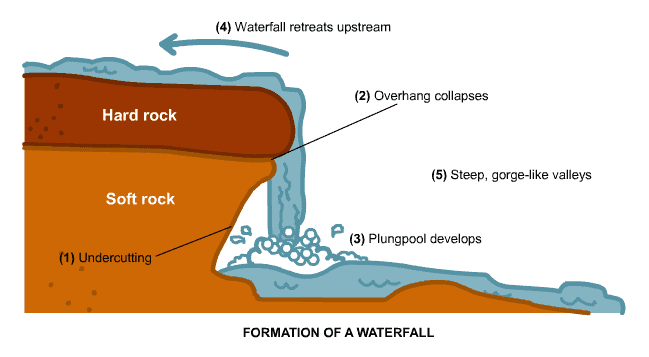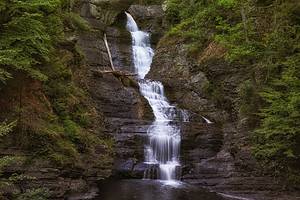There are over 7,800 known waterfalls in the world. Some of these may only be witnessed in specific seasons, while others can be found year-round. Some of the rarest waterfalls deposit directly into the ocean as opposed to a freshwater source—only 31 to be exact. Yes, undoubtedly, waterfalls are one of the most unique water phenomena to occur in the world. But, how do waterfalls form, and why?
Below, explore the science behind waterfalls, plus what exactly a waterfall is and why they form.
What is a Waterfall?

Waterfalls are freshwater rivers or streams that descend over a cliff of variable size.
©mbrand85/Shutterstock.com
A waterfall is a moving body of freshwater, usually a river or stream, that descends over a cliff. The water falls into what is known as a plunge pool, which can be fresh- or saltwater. Although the most common image of a waterfall is a large, gushing current falling hundreds of feet into the plunge pool, not all waterfalls look this way. The town of Newington, Connecticut claims to have the smallest waterfall, with Mill Pond Falls measuring at 12 feet.
However, not all water that falls can be considered a waterfall. According to the American Rivers organization, a waterfall must be at least five feet in height. It must also come from a regular source, even if that source only replenishes once a year as is the case with many seasonal waterfalls.
Sometimes, waterfalls are also known as cascades. However, a cascade may also be a particular type of waterfall. Learning about the flow of the water and how the waterfall formed can be beneficial with looking for distinctions.
How Do Waterfalls Form?

A waterfall will occur when rock erodes at unequal rates.
©Created by Jerry Crimson Mann / CC BY-SA 3.0 – License
Waterfalls form as a result of erosion. Early on in the life of a river, the water tends to move at faster, more powerful rates. This is because the waters have not had time to create a wide, slow-moving channel. As a result, when the water moves across the surface of the planet, it moves with its sediment.
In certain areas, hard rock sits on top of soft rock. As the water moves, it erodes the softer rock at a faster rate than the hard rock. This results in a steep drop in which the water can descend, creating breathtaking waterfall views. However, as a result, not all waterfalls begin with major heights. Instead, the height of the drop increases as more of the soft rock is eroded and carried downstream while the hard rock remains.
How Do Waterfalls Never Run Out of Water?

The bottom of a waterfall is known as a plunge pool.
©Sundry Photography/Shutterstock.com
Sometimes, depending on the season, the sources for some waterfalls may dry out. However, when the rainy season returns, the rivers and streams will refill, and the waterfall will continue to fall.
However, for those waterfalls that flow all year, how do they never run out of water? As it turns out, for a waterfall to run out of water, it would take either human interference or for the water cycle to cease. When thinking about the journey of water, it may seem linear. Water flowers out of a lake or pond through a river and deposits into the ocean. However, the journey of water is actually a cycle.
While the above description does occur, once the water reaches the ocean, it evaporates. This forms precipitation, like rain, that then returns water to the source of the waterfalls. The water cycle could also go more in-depth, featuring details such as run-off, groundwater, and transpiration.
However, in summary, waterfalls don’t run out of water because rain and snow are always returning water to the source of the waterfall. If humans were to redirect the source of water away from the waterfall, if an unnaturally long drought were to occur, or if the water cycle stopped altogether are the main ways in which a waterfall would run out of water.
Types of Waterfalls

There are many types of waterfalls in the world with various different ways to classify them.
©Jeremy Christensen/Shutterstock.com
There are several different types of waterfalls found throughout the world. Although there is no single, official way to categorize waterfalls, one of the most popular ways is by type. Each type of waterfall refers to the different ways in which the water may descend.
For example, the Niagra Falls in North America is a block waterfall. This means that the water comprising the falls descends from a wide river. In contrast, a chute waterfall descends from a narrow stream, resulting in higher-pressure falls.
Waterfall types may also be named by the shape of the water as it descends. Fan waterfalls, for example, involve water spreading out horizontally, like a paper fan, as it falls.
Some of the main types of waterfalls include:
- Block waterfalls
- Cascade
- Cataract
- Chute
- Fan waterfalls
- Frozen waterfalls
- Horsetail waterfalls
- Multistep waterfalls
- Plunge waterfalls
- Punchbowl waterfalls
- Segmented waterfalls.
The photo featured at the top of this post is © Mihai_Andritoiu/Shutterstock.com
Thank you for reading! Have some feedback for us? Contact the AZ Animals editorial team.






